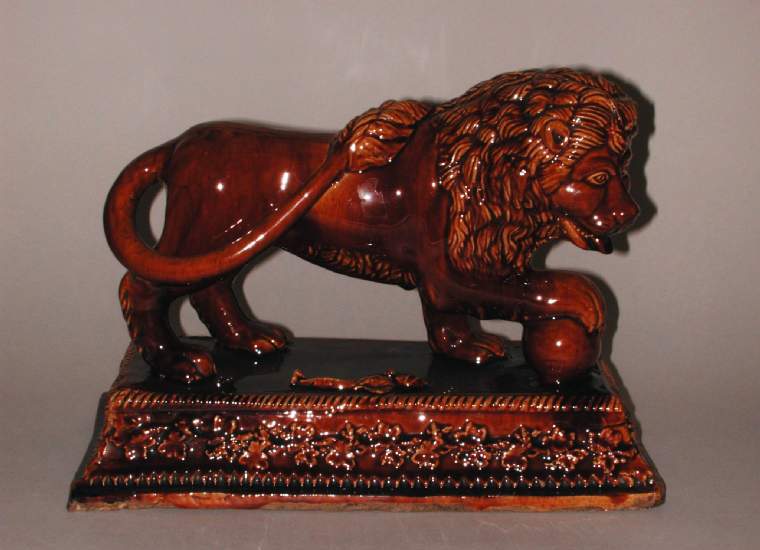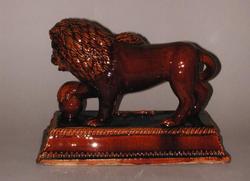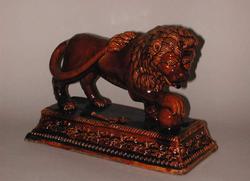Current Location: Gallery 27 (Glaisher)
Titles
Lion
Maker(s)
Production:
Unidentified factory
(Probably)
Entities
Categories
Description
Pale buff earthenware figure, moulded with modelled additions and coated with manganese brown lead glaze.
Large animal figure of a lion standing on a rectangular plinth. Its right foot is raised on a ball, its tail curls onto its back and its tongue protrudes from an open mouth. The tiny figure of a soldier lying prostrate is relief moulded on top of the plinth, between the lion’s right feet. The whole piece has been dipped in a rich brown glaze which highlights the relief features, where the glaze coat is thinner. The sides of the plinth slope down to a slightly larger base and are decorated with a rope pattern around the top, a tooth pattern at the bottom and a vine leaf frieze around the front and two sides. The underside is recessed and unglazed.
Notes
History note: Bought from Mr Frost at Hitchin on 26 November 1908, for £1, by Dr J.W.L. Glaisher, Trinity College, Cambridge.
Legal notes
Dr J. W. L. Glaisher Bequest, 1928
Measurements and weight
Height: 23.5 cm
Acquisition and important dates
Method of acquisition: Bequeathed
(1928)
by
Glaisher, J. W. L., Dr
Dating
19th Century, first half
Circa
1810
-
1840
Note
The rich brown glaze used here is sometimes known as ‘Rockingham’, after a glaze developed at the Rockingham Works, Swinton, nr Rotherham, c.1770. However, other potteries also produced this type of finish on relief wares in the early-mid 19th Century and Dr Glaisher was told by the vendor that the source of this piece was Staffordshire.
These lions were generally made in pairs, one facing each way and perhaps intended to sit either end of a dresser. However, one in the Fitzwilliam collection appears instead to be the companion of a tiger, which holds a lifeless soldier in its mouth. The tiger figure represents the death of Lieutenant Hugh Munro who was mauled by a tiger in India in 1792 (see C.967-1928). It may be that this association inspired the unusual feature of the small soldier lying on the plinth, here – which, according to Dr Glaisher’s notes, was also to be found on the pair.
This is one of several similar lions in the Fitzwilliam collection and was originally one of a pair. Dr Glaisher decided not to buy the other, he notes ‘one was enough’. The figure is based on a pair which stands at the entrance of the Loggia dei Lanzi in Florence, one a 2nd Century Roman figure and its companion sculpted by Flaminio Vacca in 1594. Moved to Florence in 1789, the lions became well known as small scale reproductions in stone, marble, plaster and bronze and these, rather than the originals, may have been the source for the earthenware lions which were popular in the early 19th Century.
People, subjects and objects depicted
Components of the work
Decoration
composed of
lead-glaze
( manganese brown)
Base
Depth 16 cm
Width 32.5 cm
Parts
Materials used in production
buff
Earthenware
Techniques used in production
Moulding
: Earthenware, moulded, modelled and lead glazed.
References and bibliographic entries
Identification numbers
Accession number: C.1079-1928
Primary reference Number: 71278
Old object number: 2919
Stable URI
Audit data
Created: Saturday 6 August 2011
Updated: Tuesday 30 April 2024
Last processed: Tuesday 15 July 2025
Associated departments & institutions
Owner or interested party:
The Fitzwilliam Museum
Associated department:
Applied Arts






